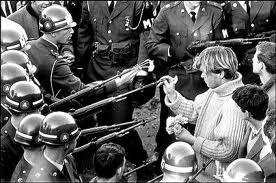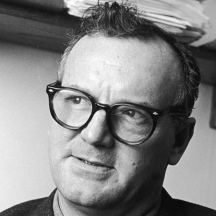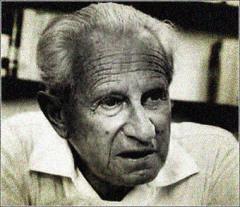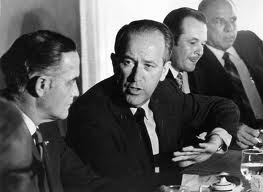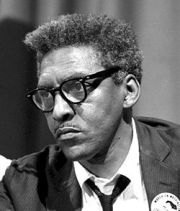Politics
Politics: Ripping Off Young America: The College-Loan Scandal
By Matt Taibbi
August 15, 2013 | 10:45am EDT
August 15, 2013 | 10:45am EDT
![[Image]](http://dam.cloud.kargo.com/access/show/id/MobileWAP.Rollingstone:PoliticsRippingOffYo_1376578215/ds/resize/width/160/file.jpg) Full Size Image
Full Size Image
Illustration by Victor Juhasz
On May 31st, president Barack Obama strolled into the bright
sunlight of the Rose Garden, covered from head to toe in the slime and
ooze of the Benghazi and IRS scandals. In a Karl Rove-ian masterstroke,
he simply pretended they weren't there and changed the subject.More Taibbi: The Last Mystery of the Financial Crisis
The topic? Student loans. Unless Congress took action soon, he warned, the relatively low 3.4 percent interest rates on key federal student loans would double. Obama knew the Republicans would make a scene over extending the subsidized loan program, and that he could corner them into looking like obstructionist meanies out to snatch the lollipop of higher education from America's youth. "We cannot price the middle class or folks who are willing to work hard to get into the middle class," he said sternly, "out of a college education."
Flash-forward through a few months of brinkmanship and name-calling, and not only is nobody talking about the IRS anymore, but the Republicans and Democrats are snuggled in bed together on the student-loan thing, having hatched a quick-fix plan on July 31st to peg interest rates to Treasury rates, ensuring the rate for undergrads would only rise to 3.86 percent for the coming year.
Though this was just the thinnest of temporary solutions – Congressional Budget Office projections predicted interest rates on undergraduate loans under the new plan would still rise as high as 7.25 percent within five years, while graduate loans could reach an even more ridiculous 8.8 percent – the jobholders on Capitol Hill couldn't stop congratulating themselves for their "rare" "feat" of bipartisan cooperation. "This proves Washington can work," clucked House Republican Luke Messer of Indiana, in a typically autoerotic assessment of the work done by Beltway pols like himself who were now freed up for their August vacations.
Not only had the president succeeded in moving the goal posts on his spring scandals, he'd teamed up with the Republicans to perpetuate a long-standing deception about the education issue: that the student-loan controversy is now entirely about interest rates and/or access to school loans.
Obama had already set himself up as a great champion of student rights by taking on banks and greedy lenders like Sallie Mae. Three years earlier, he'd scored what at the time looked like a major victory over the Republicans with a transformative plan to revamp the student-loan industry. The 2010 bill mostly eliminated private banks and lenders from the federal student-loan business. Henceforth, the government would lend college money directly to students, with no middlemen taking a cut. The president insisted the plan would eliminate waste and promised to pass the savings along to students in the form of more college and university loans, including $36 billion in new Pell grants over 10 years for low-income students. Republican senator and former Secretary of Education Lamar Alexander bashed the move as "another Washington takeover."
The thing is, none of it – not last month's deal, not Obama's 2010 reforms – mattered that much. No doubt, seeing rates double permanently would genuinely have sucked for many students, so it was nice to avoid that. And yes, it was theoretically beneficial when Obama took banks and middlemen out of the federal student-loan game. But the dirty secret of American higher education is that student-loan interest rates are almost irrelevant. It's not the cost of the loan that's the problem, it's the principal – the appallingly high tuition costs that have been soaring at two to three times the rate of inflation, an irrational upward trajectory eerily reminiscent of skyrocketing housing prices in the years before 2008.
More Taibbi: The Biggest Price-Fixing Scandal Ever
How is this happening? It's complicated. But throw off the mystery and what you'll uncover is a shameful and oppressive outrage that for years now has been systematically perpetrated against a generation of young adults. For this story, I interviewed people who developed crippling mental and physical conditions, who considered suicide, who had to give up hope of having children, who were forced to leave the country, or who even entered a life of crime because of their student debts.
They all take responsibility for their own mistakes. They know they didn't arrive at gorgeous campuses for four golden years of boozing, balling and bong hits by way of anybody's cattle car. But they're angry, too, and they should be. Because the underlying cause of all that later-life distress and heartache – the reason they carry such crushing, life-alteringly huge college debt – is that our university-tuition system really is exploitative and unfair, designed primarily to benefit two major actors.
First in line are the colleges and universities, and the contractors who build their extravagant athletic complexes, hotel-like dormitories and God knows what other campus embellishments. For these little regional economic empires, the federal student-loan system is essentially a massive and ongoing government subsidy, once funded mostly by emotionally vulnerable parents, but now increasingly paid for in the form of federally backed loans to a political constituency – low- and middle-income students – that has virtually no lobby in Washington.
Next up is the government itself. While it's not commonly discussed on the Hill, the government actually stands to make an enormous profit on the president's new federal student-loan system, an estimated $184 billion over 10 years, a boondoggle paid for by hyperinflated tuition costs and fueled by a government-sponsored predatory-lending program that makes even the most ruthless private credit-card company seem like a "Save the Panda" charity. Why is this happening? The answer lies in a sociopathic marriage of private-sector greed and government force that will make you shake your head in wonder at the way modern America sucks blood out of its young.
In the early 2000s, a thirtysomething scientist named Alan Collinge seemed to be going places. He had graduated from USC in 1999 with a degree in aerospace engineering and landed a research job at Caltech. Then he made a mistake: He asked for a raise, didn't get it, lost his job and soon found himself underemployed and with no way to repay the roughly $38,000 in loans he'd taken out to get his degree.
Collinge's creditor, Sallie Mae, which originally had been a quasi-public institution but, in the late Nineties, had begun transforming into a wholly private lender, didn't answer his requests for a forbearance or a restructuring. So in 2001, he went into default. Soon enough, his original $38,000 loan had ballooned to more than $100,000 in debt, thanks to fees, penalties and accrued interest. He had a job as a military contractor, but he lost it when his employer ran a credit check on him. His whole life was now about his student debt.
More Taibbi: The Scam Wall Street Learned From the Mafia
Collinge became so upset that, while sitting on a buddy's couch in Tacoma, Washington, one night in 2005 and nursing a bottle of Jack Daniel's, he swore that he'd see Sallie Mae on 60 Minutes if it was the last thing he did. In what has to be a first in the history of drunken bullshitting, it actually happened. "Lo and behold, I ended up being featured on 60 Minutes within about a year," he says. In 2006, he got to tell his debt story to Lesley Stahl for a piece on Sallie Mae's draconian lending tactics that, curiously enough, Sallie Mae itself refused to be interviewed for.
From that point forward, Collinge – who founded the website StudentLoanJustice.org – became what he calls "a complaint box for the industry." He heard thousands of horror stories from people like himself, and over the course of many years began to wonder more and more about one particular recurring theme, what he calls "the really significant thing – the sticker price." Why was college so expensive?
Tuition costs at public and private colleges were, are and have been rising faster than just about anything in American society – health care, energy, even housing. Between 1950 and 1970, sending a kid to a public university cost about four percent of an American family's annual income. Forty years later, in 2010, it accounted for 11 percent. Moody's released statistics showing tuition and fees rising 300 percent versus the Consumer Price Index between 1990 and 2011.
After the mortgage crash of 2008, for instance, many states pushed through deep cuts to their higher-education systems, but all that did was motivate schools to raise tuition prices and seek to recoup lost state subsidies in the form of more federal-loan money. The one thing they didn't do was cut costs. "College spending has been going up at the same time as prices have been going up," says Kevin Carey of the nonpartisan New America Foundation.
This is why the issue of student-loan interest rates pales in comparison with the larger problem of how anyone can repay such a huge debt – the average student now leaves school owing $27,000 – by entering an economy sluggishly jogging uphill at a fraction of the speed of climbing education costs. "It's the unending, gratuitous, punitive increase in prices that is driving all of this," says Carey.
As Collinge worked to figure out the cause of those cost increases, he became focused on several highly disturbing, little-discussed quirks in the student-lending industry. For instance: A 2005 Wall Street Journal story by John Hechinger showed that the Department of Education was projecting it would actually make money on students who defaulted on loans, and would collect on average 100 percent of the principal, plus an additional 20 percent in fees and payments.
Hechinger's reporting would continue over the years to be borne out in official documents. In 2010, for instance, the Obama White House projected the default recovery rate for all forms of federal Stafford loans (one of the most common federally backed loans for undergraduates and graduates) to be above 122 percent. The most recent White House projection was slightly less aggressive, predicting a recovery rate of between 104 percent and 109 percent for Stafford loans.
When Rolling Stone reached out to the DOE to ask for an explanation of those numbers, we got no answer. In the past, however, the federal government has responded to such criticisms by insisting that it doesn't make a profit on defaults, arguing that the government incurs costs farming out negligent accounts to collectors, and also loses even more thanks to the opportunity cost of lost time. For instance, the government claimed its projected recovery rate for one type of defaulted Stafford loans in 2013 to be 109.8 percent, but after factoring in collection costs, that number drops to 95.7 percent. Factor in the additional cost of lost time, and the "net" projected recovery rate for these Stafford loans is 81.8 percent.
Still, those recovery numbers are extremely high, compared with, say, credit-card debt, where recovery rates of 15 percent are not uncommon. Whether the recovery rate is 110 percent or 80 percent, it seems doubtful that losses from defaults come close to impacting the government's bottom line, since the state continues to project massive earnings from its student-loan program. After the latest compromise, the 10-year revenue projection for the DOE's lending programs is $184,715,000,000, or $715 million higher than the old projection – underscoring the fact that the latest deal, while perhaps rescuing students this coming year from high rates, still expects to ding them hard down the road.
But the main question is, how is the idea that the government might make profits on defaulted loans even up for debate? The answer lies in the uniquely blood-draining legal framework in which federal student loans are issued. First of all, a high percentage of student borrowers enter into their loans having no idea that they're signing up for a relationship as unbreakable as herpes. Not only has Congress almost completely stripped students of their right to disgorge their debts through bankruptcy (amazing, when one considers that even gamblers can declare bankruptcy!), it has also restricted the students' ability to refinance loans. Even Truth in Lending Act requirements – which normally require lenders to fully disclose future costs to would-be customers – don't cover certain student loans. That student lenders can escape from such requirements is especially pernicious, given that their pool of borrowers are typically one step removed from being children, but the law goes further than that and tacitly permits lenders to deceive their teenage clients.
Not all student borrowers have access to the same information. A 2008 federal education law forced private lenders to disclose the Annual Percentage Rate (APR) to prospective borrowers; APR is a more complex number that often includes fees and other charges. But lenders of federally backed student loans do not have to make the same disclosures.
"Only a small minority of those who've been to college have been told very simple things, like what their interest rate was," says Collinge. "A lot of straight-up lies have been foisted on students."
Talk to any of the 38 million Americans who have outstanding student-loan debt, and he or she is likely to tell you a story about how a single moment in a financial-aid office at the age of 18 or 19 – an age when most people can barely do a load of laundry without help – ended up ruining his or her life. "I was 19 years old," says 24-year-old Lyndsay Green, a graduate of the University of Alabama, in a typical story. "I didn't understand what was going on, but my mother was there. She had signed, and now it was my turn. So I did." Six years later, she says, "I am nearly $45,000 in debt. . . . If I had known what I was doing, I would never have gone to college."
"Nobody sits down and explains to you what it all means," says 24-year-old Andrew Geliebter, who took out loans to get what he calls "a degree in bullshit"; he entered a public-relations program at Temple University. His loan payments are now 50 percent of his gross income, leaving only about $100 a week for groceries for his family of four.
Another debtor, a 38-year-old attorney who suffered a pulmonary embolism and went into default as a result, is now more than $100,000 in debt. Bedridden and fully disabled, he accepts he will likely be in debt until his death. He asked that his name be withheld because he doesn't want to incur the wrath of the government by disclosing the awful punch line to his story: After he qualified for federal disability payments in 2009, the Department of Education quickly began garnishing $170 a month from his disability check.
"Student-loan debt collectors have power that would make a mobster envious" is how Sen. Elizabeth Warren put it. Collectors can garnish everything from wages to tax returns to Social Security payments to, yes, disability checks. Debtors can also be barred from the military, lose professional licenses and suffer other consequences no private lender could possibly throw at a borrower.
The upshot of all this is that the government can essentially lend without fear, because its strong-arm collection powers dictate that one way or another, the money will come back. Even a very high default rate may not dissuade the government from continuing to make mountains of credit available to naive young people.
"If the DOE had any skin in the game," says Collinge, "if they actually saw significant loss from defaulted loans, they would years ago have said, 'Whoa, we need to freeze lending,' or, 'We need to kick 100 schools out of the lending program.'"
Turning down the credit spigot would force schools to compete by bringing prices down. It would help to weed out crappy schools that hawked worthless "degrees in bullshit." It would also force prospective students to meet higher standards – not just anyone would get student loans, which is maybe the way it should be.
But that's not how it is. For one thing, the check on crappy schools and sleazy "diploma mill" institutions is essentially broken thanks to a corrupt dynamic similar to the way credit-rating agencies have failed in the finance world. Schools must be accredited institutions to receive tuition via federal student loans, but the accrediting agencies are nongovernmental captives of the education industry. "The government has outsourced its responsibilities for ensuring quality to weak, nonprofit organizations that are essentially owned and run by existing colleges," says Carey.
Fly-by-night, for-profit schools can be some of the most aggressive in lobbying for the raising of federal-loan limits. The reason is simple – some of them subsist almost entirely on federal loans. There's actually a law prohibiting these schools from having more than 90 percent of their tuition income come from federally backed loans. It would seem to amaze that any school would come even close to depending that much on taxpayers, but Carey notes with disdain that some schools use loopholes to go beyond the limit (for instance, loans to servicemen are technically issued through the Department of Defense, so they don't count toward the 90 percent figure).
Bottomless credit equals inflated prices equals more money for colleges and universities, more hidden taxes for the government to collect and, perhaps most important, a bigger and more dangerous debt bomb on the backs of the adult working population.
The stats on the latter are now undeniable. Having passed credit cards to became the largest pile of owed money in America outside of the real-estate market, outstanding student debt topped $1 trillion by the end of 2011. Last November, the New York Fed reported an amazing statistic: During just the third quarter of 2012, non-real-estate household debt rose nationally by 2.3 percent, or a staggering $62 billion. And an equally staggering $42 billion of that was student-loan debt.
The exploding-debt scenario is such a conspicuous problem that the Federal Advisory Council – a group of bankers who advise the Federal Reserve Board of Governors – has compared it to the mortgage crash, warning that "recent growth in student-loan debt . . . has parallels to the housing crisis." Agreeing with activists like Collinge, it cited a "significant growth of subsidized lending" as a major factor in the student-debt mess.
One final, eerie similarity to the mortgage crisis is that while analysts on both the left and the right agree that the ballooning student-debt mess can be blamed on too much easy credit, there is sharp disagreement about the reason for the existence of that easy credit. Many finance-sector analysts see the problem as being founded in ill-considered social engineering, an unrealistic desire to put as many kids into college as possible that mirrors the state's home-ownership goals that many conservatives still believe fueled the mortgage crisis. "These problems are the result of government officials pushing a social good – i.e., broader college attendance" is how libertarian writer Steven Greenhut put it.
Others, however, view the easy money as the massive subsidy for an education industry, which spent between $88 million and $110 million lobbying government in each of the past six years, and historically has spent recklessly no matter who happened to be footing the bill – parents, states, the federal government, young people, whomever.
Carey talks about how colleges spend a lot of energy on what he calls "gilding" – pouring money into superficial symbols of prestige, everything from new buildings to celebrity professors, as part of a "never-ending race for positional status."
"What you see is that spending on education hasn't really gone up all that much," he says. "It's spending on things like buildings and administration. . . . Lots and lots of people getting paid $200,000, $300,000 a year to do . . . something."
Once upon a time, when the economy was healthier, it was parents who paid for these excesses. "But eventually those people ran out of money," Carey says, "so they had to start borrowing."
If federal loan programs aren't being swallowed up by greedy schools for expensive and useless gilding, they're being manipulated by the federal government itself. The massive earnings the government gets on student-loan programs amount to a crude backdoor tax increase disguised by cynical legislators (who hesitate to ask constituents with more powerful lobbies to help cut the deficit) as an investment in America's youth.
"It's basically a $185 billion tax hike on middle-income and low-income citizens and their families," says Warren Gunnels, senior policy adviser for Vermont's Sen. Bernie Sanders, one of the few legislators critical of the recent congressional student-loan compromise.
Gunnels notes with irony that a few years ago, when Obama moved to eliminate private-lender middlemen from the servicing of federally backed loans, much hay was made out of the enormous profits private industry had long earned on the backs of students. The Congressional Budget Office issued a report estimating that Obama's program would save $86.8 billion over a 10-year period by eliminating private profits from the system. Obama said taxpayers were "paying banks a premium to act as middlemen," adding that it was a "premium we cannot afford."
The outrage over profits, however, was short-lived.
"It was wrong when banks were making an $86 billion profit on students, but somehow it's OK when the government makes a $185 billion profit on them," says Gunnels.
One of the reasons the money has kept flying out the government's door over the years is that data about student-loan-default rates has been carefully concealed from the public and from Congress. For years, when it reported statistics about student defaults, the DOE relied upon a preposterous arbitrary calculation called the "cohort default rate," which essentially measured the rate of default only within the first two years of graduation. In 2008, Congress passed a law forcing the DOE to switch to a theoretically more accurate three-year measurement, which it sent to Congress for the first time last year. Overnight, the picture looked a good bit grimmer. The 2009 number, based on the old two-year 2009 "cohort" rate, was 8.8 percent. When the new three-year number came out, the rate had jumped to 13.4 percent.
The Department of Education refuses to release more accurate default numbers. But outsiders think the DOE is lowballing it. The Chronicle of Higher Education charges that the government "vastly undercounts defaults." In 2010, it estimated that one in five had defaulted on their loans since 1995, that 31 percent of community-college students default and that an astonishing 40 percent of students attending for-profit schools end up defaulting. A report by the Inspector General of the Department of Education has come to similar conclusions about the reliability of the absurd and arbitrary "cohort" figure.
However high that default number really is, what's clear is that the state is still able to turn billions in profit on its lending, and expects to continue to do so for the next 10 years. The reason for that, again, lies in something everyone who has a student loan understands implicitly – the state and its collectors are not -squeamish collecting the money they're owed. The government is in the pain business, and business is good.
"They called me at work, sometimes two to three times a day, doing all the stuff they aren't supposed to do: threats, et cetera," says 41-year-old Shawn FitzGerald, who owes $300 a month and says he expects to be paying off education loans into his sixties. "They told the receptionist at my job that I was in legal trouble. . . ."
"Sallie Mae has started sending letters to my deceased mother," says Thomas Daggett of Chesterfield, Massachusetts, who left school in the Nineties and owes $35,000.
"I have been told I made the wrong decision going to college, as well as being told I was a failure, an idiot and a mooch," says Larissa, a young woman from a blue-collar town outside Chicago. "I've had ex-boyfriends that I never even lived with contacted by collection agents, my childhood friend's distant relatives contacted by them, as well as distant relatives of my own. . . ."
"I try not to look at the balances because the prospect of paying them off with my shit salary is so goddamn depressing it makes me want to chug vodka until I pass out," says Robert Boardman, a proud but underemployed owner of a doctorate from the University of Michigan.
There's a particularly dark twist to the education story, which is tied to the collapse of the middle class and the overall shittening of our economic landscape: College degrees are actually considered to be more essential than ever. The New York Times did a story earlier this year declaring the college degree to be the "new high school diploma," describing it as essentially a minimum job requirement. They found an Atlanta law firm that requires even clerks, secretaries and runners to have four-year degrees and cited research that everyone from hygienists to cargo agents needs to have graduated from college to get hired.
You can look at this development in one of two ways. One way is to see a college degree as a better investment than ever, which was the conclusion of the Organization for Economic Cooperation and Development, which noted that the difference in earnings between the poorly and well-educated has risen in recent years with the worsening economy.
But another way to look at this new truth is that, because of the poor job market, young people may have less of a chance than ever to actually get a good job commensurate with their education. If they don't have the degree, then they have no chance at all. So if they even want a clerking job, they must dive face-first into the debt muck and take their chances that they won't end up watching the federal government take bites out of disability checks while their law degree gathers dust downstairs somewhere. So, yes, a college education is a great thing, and you probably need one now more than ever – the problem is that it may very well be mandatory, may have less of a chance of ever getting you a job, and you may still be paying for it on your deathbed no matter what.
There are powerful reasons for both the left and the right to be willfully blind to the root problem. Democrats – who, incidentally, receive at least twice as much money from the education lobby as Republicans – like to see the raging river of free-flowing student loans as a triumph of educational access. Any suggestion that saddling befuddled youngsters with tens of thousands of dollars in school debts is somehow harmful or counterproductive to society is often swiftly shot down by politicians or industry insiders as an anti-student position. The idea that limitless government credit might be at least enabling high education costs tends to be derisively described as the "Bennett hypothesis," since right-wing moralist and notorious gambler/dick/hypocrite Bill Bennett once touted the same idea.
"It is wrong to suggest that student aid is a cause for growing college costs, in any sector," David Warren, president of the National Association of Independent Colleges and Universities, wrote in The Washington Post last year, bemoaning the "re-emergence" of the Bennett theory. "To argue so is counterproductive to the goal of making higher education accessible and affordable."
Conservatives, meanwhile, with their usual "Fuck everybody who complains about anything unless it's us" mentality, tend to portray the student-loan "problem" as a bunch of spoiled, irresponsible losers who are simply whining about having to pay back money they borrowed with their eyes wide open. When Yale and Penn State recently began suing students who were defaulting on their federal Perkins loans, a Cato Institute analyst named Neal McCluskey pretty much summed up the conservative take. "You could take a job at Subway or wherever to pay the bills," he said. "It seems like basic responsibility to me."
But conservatives most of all should hate the current system for any number of reasons – for being a massive hidden tax, for being a market-defying subsidy artificially keeping ineffective and poor-performing institutions in business, and for being an example of arbitrary government power seizing not just money borrowed plus interest, but billions in additional fees and penalties from ordinary people.
Progressives should hate the predatory tactics of lenders and the sleazy way universities rely upon loan-shark collection methods to keep themselves in fancy new waterfalls, swimming pools and tenure-track jobs.
But nobody hates it enough, except for the people actually trying to pay the bills with increasingly worthless degrees. Instead, the credit keeps flowing and the debt bubble keeps expanding, thanks to leaders like John Boehner (whose daughter reportedly works at Sallie Mae's student-collections firm, General Revenue Corp.) and Dianne Feinstein (who introduced legislation to increase limits on Pell grants while her husband was heavily invested in for-profit colleges).
In a way, America itself is violating the Truth in Lending Act. It's cheering millions of high school graduates toward college every year, feeding them into the debt grinder under the banner of increased opportunity, when full disclosure would require admitting that there isn't a hell of a lot waiting for them on the other side, where the middle class has nearly vanished and full employment is going the way of the dodo.
We're doing the worst thing people can do: lying to our young. Nobody, not even this president, who was swept to victory in large part by the raw enthusiasm of college kids, has the stones to tell the truth: that a lot of them will end up being pawns in a predatory con game designed to extract the equivalent of home-mortgage commitment from 17-year-olds dreaming of impossible careers as nautical archaeologists or orchestra conductors. One former law student I contacted for this story had a nervous breakdown while struggling to pay off six-figure debt. It wasn't until he tapped into one of the few growth industries open to young Americans that his outlook brightened. "I got my life back on track by working for a marijuana delivery service in Manhattan," he says. "I've had to compromise who I am . . . because I started down a path that I couldn't turn away from. Student loans aren't hope. They're despair."
This story is from the August 29th, 2013 issue of Rolling Stone.
Related Links
Obama and the Road Ahead: The Rolling Stone Interview
Why Didn't the SEC Catch Madoff? It Might Have Been Policy Not To
The Growing Sentiment on the Hill For Ending 'Too Big To Fail'



